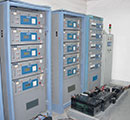

It goes without saying that a battery with a longer lifetime provides economic benefits in terms of lower replacement costs, but a longer lasting battery can prove particularly beneficial for certain types of application.
The usage of a battery can be roughly divided into cyclic use and standby use. When a battery is being used as a power source regularly and it is being discharged and subsequently recharged, this can be considered cyclic use. Examples of this type of use include batteries for golf carts, stackers, toy cars, portable power tools, etc.
Standby use is also known as float use, in which the application applies the battery as an alternate source of power – it is used during emergencies upon failure of the main power source. Batteries used in alarm systems, emergency lights and UPSs are some examples of applications in standby use. Standby batteries are kept fully charged so that they can provide service immediately when the power has been cut off. The batteries remain connected to a trickle charger in float charging mode in order to keep them fully charged and ready for use anytime.

The battery lifetime is definitely an important consideration when choosing a battery, however the battery cycle life is of more emphasis for applications characterised by cyclic use.
To ensure users get maximum usage from its batteries, Forbatt attaches great importance to quality, in everything from materials to assembly processes. Since those factors ultimately affect battery performance and lifetime, Forbatt’s batteries are manufactured with the highest quality cells and components to give an excellent and stable performance. The battery plate, for example, utilises a lead-calcium alloy and a small amount of tin and calcium in the grid alloy imparts strength to the plate and durability in cycle service. The lead-calcium alloy grid structure provides an extra margin of performance and life, and ensures superior recovery from discharge.
Forbatt has more than 40 years’ experience in manufacturing batteries. By thoroughly reviewing each step of manufacture with the rigorous supervision of the company’s quality control system, it strives to continually ensure its production processes, products and service meet the highest standards of quality.
What lifetime should you expect?
There are several factors that may affect the lifetime of a battery, including its design, the application, operating temperature, charging/discharging method, storage conditions and maintenance. In general, a battery used in standby applications has a longer expectation of battery life than a battery in cyclic use. However, the battery designed for cyclic use may have a better outcome than the standby battery in a cycle life test.
Standby life or float life is the life expectancy of a battery under continuous charge. In standby use, the battery has a design life up to three years that varies with the frequency and depth of discharge, the float voltage and the ambient temperature.
Unlike the float life, the battery cycle life is the number of charge and discharge cycles that can be achieved before a battery reaches the end of its useful life. In cyclical applications, from 250 up to 1000 charge and discharge cycles might be expected depending on the depth of discharge. The number of cycles depends on the capacity taken from the battery, depth of discharge, operating temperature and charging method.
How to maximise battery lifetime
What can the user do to ensure they get the maximum lifetime out of a battery, in terms of storage conditions, correct charging etc?
To obtain the maximum battery lifetime and performance, batteries should be recharged, discharged, stored and maintained in the correct way. Faulty procedures, inadequate charging methods, over-charge, over-discharge, excessive repetition of discharge, high-rate discharge and fast charge will result in failure to recover normal capacity, reduced capacity or shortened battery service life. It is important to follow the manufacturer’s instructions to select a correct charging/discharging method to protect the battery.
Also pay attention to the influence of ambient temperature. The ideal operating temperature is 20°C–25°C. A battery’s life might be shortened or it might experience a higher possibility of thermal runway when working at a high temperature.
In contrast with high temperature, the discharge time will decrease if the battery is working at a lower temperature. High ambient temperature will accelerate the deterioration of battery components. Charging at lower temperature, however, may cause generation of gas which can lead to an increase in the internal pressure of the battery or a decrease in the electrolyte, thereby shortening its service life.
The appropriate operating ambient temperature and storage conditions are as important as applying the correct charging and discharging methods. Place batteries in a cool, dry and ventilated place where the ambient temperature is around 20°C–25°C if possible, and recharge them every three months when they are not in use. Battery life will decrease with increasing temperature, so do not store and avoid operating one at an ambient temperature of higher than 40°C.
It is necessary to perform periodic maintenance to ensure optimum reliability of a battery. We recommend that inspections should be performed at least every three months. In general, periodic maintenance will include visual battery inspection, ambient temperature checking, capacity test, voltage measurement, float voltage inspection, high rate load test, and checking the resistance and tightness of connections. These procedures are designed to determine the gradual decrease of capacity and to detect any abnormal error or individual battery conditions that may impact on system reliability.
For more information contact Forbatt SA, +27 (0)11 469 3598, [email protected], www.format.co

© Technews Publishing (Pty) Ltd | All Rights Reserved